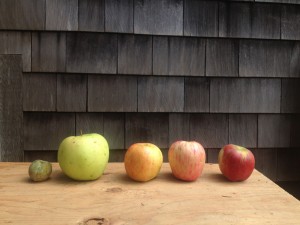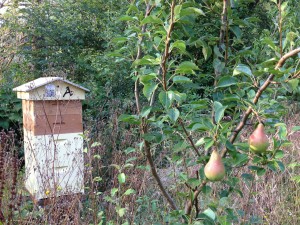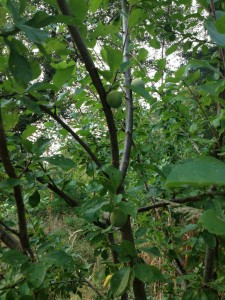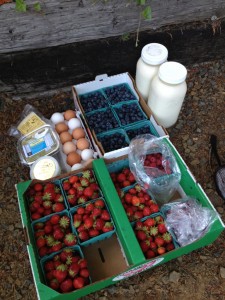We’re still working away on the house, trying to get moved in before the foul weather sets in and our bank account gets to zero from paying rent and mortgage at the same time. We’re getting close… there are three main tracks going on, so that when one gets hung up, I can work on the other: finishes, bathroom, and water supply. Water supply has taken much of my attention lately, as we’re waiting on a few things for the bathroom, and the finish work gets worked on in spare time.
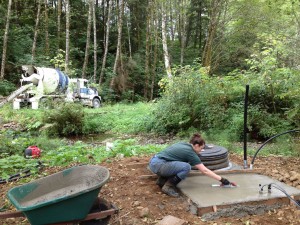 We had the well put in a few months ago, but we won’t have an operational water supply until I get the pump installed. That includes the water lines and electrical service out to it, which we’ve got in place, but we also need to build a little shelter to protect the electrical equipment and valves and so forth at the well head. It’s like building a house in miniature, but a little less complicated. Luckily, we have the skills! Here you see Emily smoothing the floor slab, as Josh and I bring the concrete in wheelbarrows from the truck (the ground is too soft around the pumphouse for a big truck like that).
We had the well put in a few months ago, but we won’t have an operational water supply until I get the pump installed. That includes the water lines and electrical service out to it, which we’ve got in place, but we also need to build a little shelter to protect the electrical equipment and valves and so forth at the well head. It’s like building a house in miniature, but a little less complicated. Luckily, we have the skills! Here you see Emily smoothing the floor slab, as Josh and I bring the concrete in wheelbarrows from the truck (the ground is too soft around the pumphouse for a big truck like that).
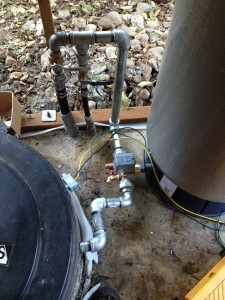 Once the slab was in place, the next job was to install the well pump. It’s a special low-head, high-volume submersible pump… normally, shallow wells like ours are run by a jet pump (which sits above the well) but they have higher power usage then a submersible pump. Those are usually for deep wells, and have a different performance curve that what we need, and are much more expensive that what we have- which uses less amps and throws water like a firehose. Here we see the pipe that go through the side of the well casing, where it then turns downward and toward the pump sitting in the bottom of the well. At the other end, it connects to the pressure tank manifold. Towards the top of the picture, you can see a few valves where the whole thing connects to the water lines (the smaller one is for a future veggie washing station).
Once the slab was in place, the next job was to install the well pump. It’s a special low-head, high-volume submersible pump… normally, shallow wells like ours are run by a jet pump (which sits above the well) but they have higher power usage then a submersible pump. Those are usually for deep wells, and have a different performance curve that what we need, and are much more expensive that what we have- which uses less amps and throws water like a firehose. Here we see the pipe that go through the side of the well casing, where it then turns downward and toward the pump sitting in the bottom of the well. At the other end, it connects to the pressure tank manifold. Towards the top of the picture, you can see a few valves where the whole thing connects to the water lines (the smaller one is for a future veggie washing station).
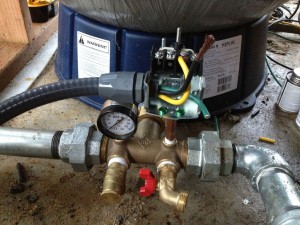 The pressure tank is partially filled with air. The idea is, the pump kicks on and pressurizes the system to a preset cutout pressure, in our case, 60 psi. When it gets that high, it turns off. When you open a faucet in the system, the pressurized air pushes the water out until the pressure drops to a cut-in pressure (40 psi) and then the pump kicks on until it gets back to 60psi. This keeps the pump from running all the time, saving electricity and wear on the machinery, while still delivering smooth water pressure. The 50-or-so psi of pressure is good for us, as it means we’ll have about 35-40psi at the house after losing some to the height difference and friction losses through the line. Incidentally, our line is really big to reduce those losses (1.5 inches!). Here you can see the pressure gauge showing “0”, right before I fired up the pump for the first time and water started squirting out of a half dozen joints I didn’t get tight enough.
The pressure tank is partially filled with air. The idea is, the pump kicks on and pressurizes the system to a preset cutout pressure, in our case, 60 psi. When it gets that high, it turns off. When you open a faucet in the system, the pressurized air pushes the water out until the pressure drops to a cut-in pressure (40 psi) and then the pump kicks on until it gets back to 60psi. This keeps the pump from running all the time, saving electricity and wear on the machinery, while still delivering smooth water pressure. The 50-or-so psi of pressure is good for us, as it means we’ll have about 35-40psi at the house after losing some to the height difference and friction losses through the line. Incidentally, our line is really big to reduce those losses (1.5 inches!). Here you can see the pressure gauge showing “0”, right before I fired up the pump for the first time and water started squirting out of a half dozen joints I didn’t get tight enough.
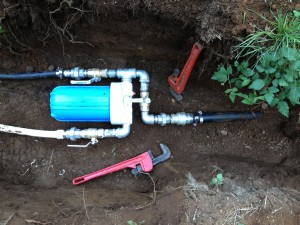 At the top of the hill, right below the house, we have a grade box with a whole-house water filter and some more valves. The big one is for the house, the smaller one will go to a yard hydrant for watering the little herb garden next to the house (and that water will be unfiltered). This is one of the places where I still have some work to do… when I pressurize the system, there is a tiny leak on one of the joints. Which is annoying, as taking all that plumbing knotwork apart is somewhat of a headache. But not as much as the one in the pumphouse, which I took apart eight times last week until I finally gave up and replaced the leaking valve entirely (which fixed the problem).
At the top of the hill, right below the house, we have a grade box with a whole-house water filter and some more valves. The big one is for the house, the smaller one will go to a yard hydrant for watering the little herb garden next to the house (and that water will be unfiltered). This is one of the places where I still have some work to do… when I pressurize the system, there is a tiny leak on one of the joints. Which is annoying, as taking all that plumbing knotwork apart is somewhat of a headache. But not as much as the one in the pumphouse, which I took apart eight times last week until I finally gave up and replaced the leaking valve entirely (which fixed the problem).
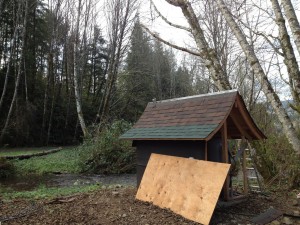 Now that the rains are back, the roof has to go onto the pumphouse. I’m still too distracted with higher priority items to get the walls/ siding on, so tar paper will have to do for now, but the roof is on. I was excited to do cedar shakes originally ($400), but figured I’d have to settle for buying asphalt shingles ($150) until Emily pointed out that I could get leftover ones at the re-store. She’s pretty good at stretching the money. That brought the roof down to $50, and only required a little creativity to accommodate the fact that they were from different color lots. I think it looks awfully good for $50.
Now that the rains are back, the roof has to go onto the pumphouse. I’m still too distracted with higher priority items to get the walls/ siding on, so tar paper will have to do for now, but the roof is on. I was excited to do cedar shakes originally ($400), but figured I’d have to settle for buying asphalt shingles ($150) until Emily pointed out that I could get leftover ones at the re-store. She’s pretty good at stretching the money. That brought the roof down to $50, and only required a little creativity to accommodate the fact that they were from different color lots. I think it looks awfully good for $50.
All this, and not a moment too soon. We got some freezing weather this week, and when I went to use the water from the rainbarrels, I found that the whole mess was frozen. So I turned the hose bibb on the side of the house, and Ta-Daah! Water. What a nice feeling.

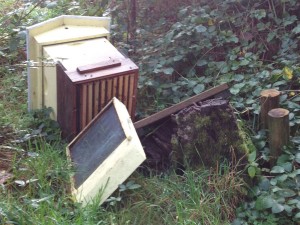
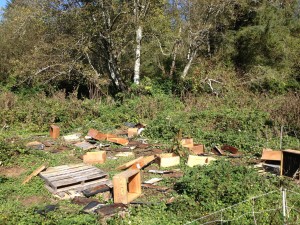




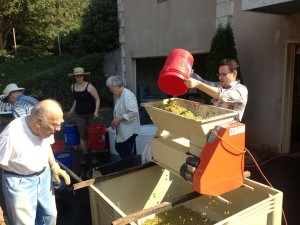
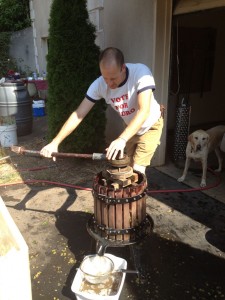
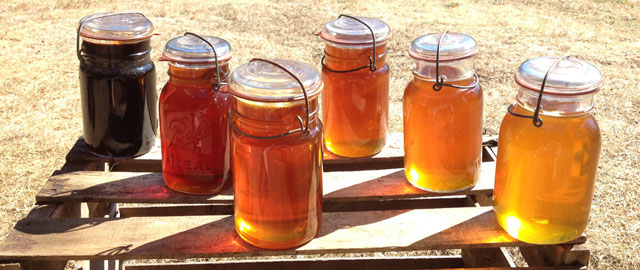


 We officially started the “decommissioning” process of the garden today, and have stopped watering and tending. What remains- mostly pumpkins and winter squash- will do fine without water, as it dries out and cures for its final stage. The focus, for now, is to get moved into the new house. Immediately thereafter, we’re going to start moving the garden from the old property to the new. We’re extremely grateful to Ryan, Julie, Betty, and Farmer Ned for all their suport while hosting us these last three years and we look forward to now living on the same property we are farming in the years to come.
We officially started the “decommissioning” process of the garden today, and have stopped watering and tending. What remains- mostly pumpkins and winter squash- will do fine without water, as it dries out and cures for its final stage. The focus, for now, is to get moved into the new house. Immediately thereafter, we’re going to start moving the garden from the old property to the new. We’re extremely grateful to Ryan, Julie, Betty, and Farmer Ned for all their suport while hosting us these last three years and we look forward to now living on the same property we are farming in the years to come.